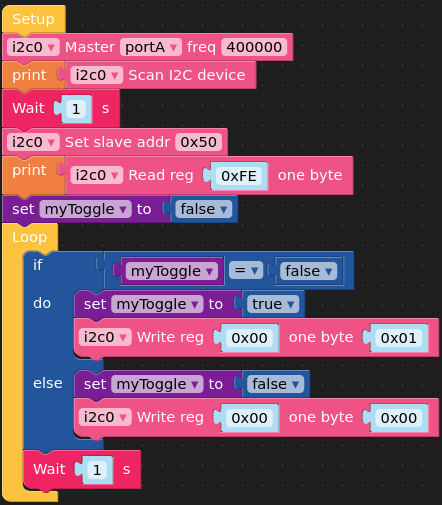ACSSR I2c control
-
First off, let me say " I Haz Dumb"!
I'm trying to run the ACSSR over I2C Using UIFLow and I can not for the life of me workout how to trigger the SSR. has anyone worked this out yet -
Hello @ajb2k3
first of all make sure when the ACSSR powers on the internal RGB LED blinks red (=I2C mode). If not, follow the instructions here to change mode. (Section Usage/Communication protocol)
Then use something like below to first scan the I2C bus, set the proper slave address, read the version and then toggle the ACSSR every second.
Note: I used an M5Atom for this example.
or from the Micropython tab:
from m5stack import * from m5ui import * from uiflow import * import i2c_bus import time myToggle = None i2c0 = i2c_bus.easyI2C(i2c_bus.PORTA, 0x00, freq=400000) print(i2c0.scan()) wait(1) i2c0.addr=(0x50) print(i2c0.read_u8(0xFE)) myToggle = False while True: if myToggle == False: myToggle = True i2c0.write_u8(0x00, 0x01) else: myToggle = False i2c0.write_u8(0x00, 0x00) wait(1) wait_ms(2)Thanks
Felix -
@felmue said in ACSSR I2c control:
Hello @ajb2k3
first of all make sure when the ACSSR powers on the internal RGB LED blinks red (=I2C mode). If not, follow the instructions here to change mode. (Section Usage/Communication protocol)
Then use something like below to first scan the I2C bus, set the proper slave address, read the version and then toggle the ACSSR every second.
Note: I used an M5Atom for this example.
or from the Micropython tab:
from m5stack import * from m5ui import * from uiflow import * import i2c_bus import time myToggle = None i2c0 = i2c_bus.easyI2C(i2c_bus.PORTA, 0x00, freq=400000) print(i2c0.scan()) wait(1) i2c0.addr=(0x50) print(i2c0.read_u8(0xFE)) myToggle = False while True: if myToggle == False: myToggle = True i2c0.write_u8(0x00, 0x01) else: myToggle = False i2c0.write_u8(0x00, 0x00) wait(1) wait_ms(2)Thanks
FelixThanks mate, I didn't know you had to set the slave address, that explains why noting is working.